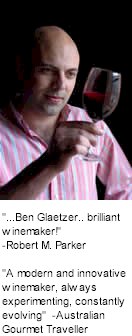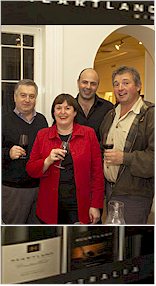


Founding Winemakers include Ben Glaetzer, fifth generation viticulturist Geoff Hardy, winemaker Scott Collett, vineyard manager John Pargeter and wine industry professional Grant Tilbrook. It was a natural progression for these good friends to pool their resources and expertise to establish their own label. All Heartland wines are made with fruit from the directors' own, mature vineyards at Limestone Coast (23km north of Padthaway) and Langhorne Creek (east of Adelaide, on the Fleurieu Peninsula - one of Australia's oldest wine regions)

There are three ranges under the Heartland Wines label, Heartland Stickleback, Heartland Coast & Creek and the flagship Directors' Cut Shiraz. Few labels will match the pedigree of this dynamic group that is attracting attention for its well-made, distinctively Australian wines. Chief winemaker Ben Glaetzer has been nominated along with father Colin for the prestigious 2004 QANTAS Australian Gourmet Traveler WINE magazine Winemaker of the Year award. Ben's, a Roseworthy graduate, grew up within the wine industry and started his career working as a cellarhand at Barossa Valley Estate and then as Winemaker at Tyrrell's.
He has travelled and worked extensively throughout the world's wine regions and is now based in the Barossa Valley where he makes the Glaetzer family wines with his father, Colin. Ben's ability to implement traditional winemaking techniques with a modern flair is reflected in such wines as Heartland Viognier Pinot Gris and Heartland Dolcetto Lagrein.
Heartland's Grant has specialised in providing advice in most aspects of vineyard operation, wine production and winery management to South Australia's wine industry. Scott Collett's family wine business, Woodstock Wines in McLaren Vale, was established by his father, Doug, in 1973. Scott took over the business after he graduated from Roseworthy in 1982. Today, he continues the family tradition at Woodstock and also adds his winemaking and entrepreneurial talents to Heartland.

Geoff Hardy is one of Australia's premier viticulturalists who has consulted to wineries throughout Australia, and in France. Geoff, a fifth generation descendant of South Australian wine pioneer Thomas Hardy, has overseen the planting of Heartland's vineyards. General Manager Vicki Arnold has worked in the wine trade in Australia and the UK for more than 20 years. She has played an active role in various wine industry groups and is currently an Australian Wine and Brandy Corporation wine inspector. Vicki brings her experience in international sales and marketing to Heartland Wines.
John Pargeter planted his first vineyard 25 years ago and now manages Heartland's 520 acre Angas Vineyard at Langhorne Creek. Having studied viticulture, he ran vineyard nurseries specialising in new grape varieties and grafting. He is chairman of the Langhorne Creek Wine Growers' Association. Gino Melino manages the 400 acre Wirrega vineyard at Limestone Coast. He draws on his family's extensive background in grape growing. He is a leader in eco-friendly methods of irrigation and pest control in the vineyard.
Over a million years ago the Heartland's Wirrega Vineyard was part of inland sea. After a series of ice ages the sea contracted, leaving a unique geological profile. The base of the vineyards is limestone formed from the abundant ancient marine life. In addition, layers of terra rossa soil have formed by decomposed limestone with high levels of oxidised iron. The Antarctic-influenced waters, the cool climate, the mainly winter rainfall, a constant artesian basin water supply and short summer make this one of the most prestigious red wine areas in Australia. The Heartland Directors' quest to secure the finest grapegrowing terroirs has ensured this winery will always craft vibrant, mouth filling wines of finesse and elegance.
Langhorne Creek is famous for a climatic phenomenon called the 'Lake Doctor'. In the growing season every afternoon a cooling ocean breeze comes through the area across the lake reducing daytime temperatures. In the growing season every afternoon a cooling ocean breeze passes through the Heartland Angas Vineyard reducing daytime temperatures. Heartland's Langhorne Creek vineyards also enjoy a unique global position, comprising of largely flat plains sheltered beyond the Mt Lofty Ranges. With low winter-dominant rainfall and moderate daytime temperatures, these carefully tended fruit parcels produce wine with richness, purity, and wonderful concentrations of flavour.
